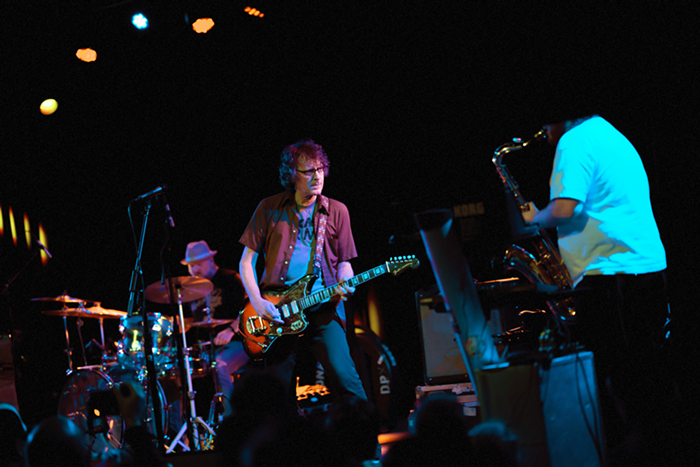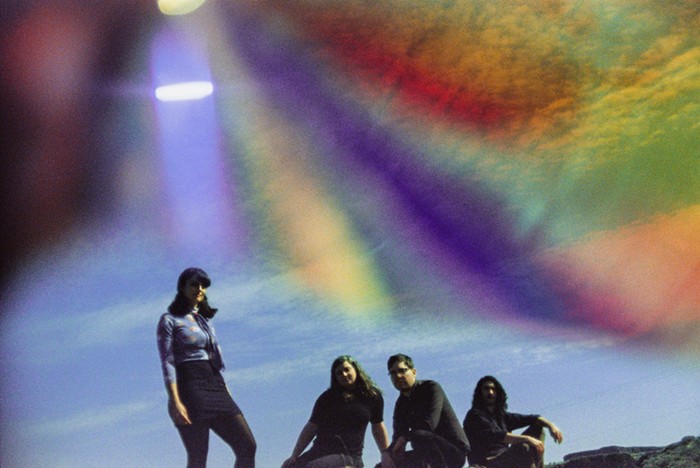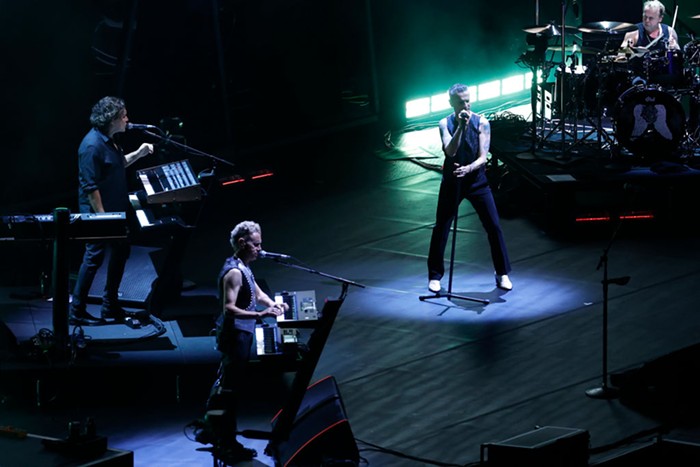The most exciting tidbit from this news item is the inclusion of Isaac Hayes' soundtrack for the film Shaft into the Library of Congress' National Recording Registry. For a blaxploitation soundtrack to receive such a governmental imprimatur is a bit surprising, even if the "Theme from Shaft" topped the singles charts in November 1971 and won the Academy Award for Best Original Song in 1972.
Hayes' sprawling, lush, and occasionally funky double LP is a worthy addition to the Registry, and it's accompanied by Creedence Clearwater Revival's "Fortunate Son," the Everly Brothers' "Cathy's Clown," Art Blakey's A Night at Birdland (Vols. 1 and 2), Elmore James' "Dust My Broom," U2's The Joshua Tree, Jeff Buckley's "Hallelujah," and 18 other recordings from 1896-1994. These works, reads the official statement, "will be preserved as cultural, artistic and/or historical treasures, representing the richness and diversity of the American soundscape."
Scan the rest of the press release after the jump.
2013 National Recording Registry (Listing in Chronological Order)
“The Laughing Song” (single)—George Washington Johnson (c. 1896)
“They Didn’t Believe Me”—Harry Macdonough and Alice Green (1915)
“Brother, Can You Spare a Dime” (singles)—Bing Crosby; Rudy Vallee (both 1932)
“Franz Boas and George Herzog Recordings of Kwakwaka’wakw Chief Dan Cranmer (1938)
“Were You There” (single)—Roland Hayes (1940)
“The Goldbergs”: Sammy Goes Into the Army (July 9, 1942)
“Caldonia” (single)—Louis Jordan (1945)
“Dust My Broom” (single)—Elmore James (1951)
“A Night at Birdland” (Vols. 1 and 2) (albums)—Art Blakey (1954)
“When I Stop Dreaming” (single)—The Louvin Brothers (1955)
“Cathy’s Clown” (single)—The Everly Brothers (1960)
“Texas Sharecropper and Songster” (album)—Mance Lipscomb (1960)
“The First Family” (album) (1962)
Lawrence Ritter’s Interviews with Baseball Pioneers of the Late 19th and Early 20th Century (1962-1966)
Presidential Recordings of Lyndon B. Johnson (Nov. 22, 1963 – Jan. 10, 1969)
“Carnegie Hall Concert with Buck Owens and His Buckaroos” (album)—Buck Owens and His Buckaroos (1966)
“Fortunate Son” (single)—Creedence Clearwater Revival (1969)
“Theme from ‘Shaft’” (album)—Isaac Hayes (1971)
“Only Visiting This Planet” (album)—Larry Norman (1972)
“Celia & Johnny” (album)—Celia Cruz and Johnny Pacheco (1974)
“Copland Conducts Copland: Appalachian Spring”—Aaron Copland (1974)
“Heart Like a Wheel” (album)—Linda Ronstadt (1974)
“Sweeney Todd” (album)—Original Cast Recording (1979)
“The Joshua Tree” (album)—U2 (1987)
“Hallelujah” (single)—Jeff Buckley (1994)
Hallelujah, the 2013 National Recording Registry Reaches 400
Art Blakey, Everly Brothers, U2 Recordings Marked for Preservation
Jeff Buckley’s haunting single “Hallelujah” from his one and only studio album; Lyndon B. Johnson’s massive collection of presidential conversations; Isaac Hayes’ landmark soundtrack album “Shaft”; and “The Laughing Song” performed by the nation’s first black recording artist are among the newest recordings selected for induction into the Library of Congress National Recording Registry. Librarian of Congress James H. Billington today announced the selection of 25 sound recordings to the registry that will be preserved as cultural, artistic and/or historical treasures, representing the richness and diversity of the American soundscape.
“These recordings represent an important part of America’s culture and history,” said Billington. “As technology continually changes and formats become obsolete, we must ensure that our nation’s aural legacy is protected. The National Recording Registry is at the core of this effort.”
Under the terms of the National Recording Preservation Act of 2000, the Librarian, with advice from the Library’s National Recording Preservation Board (NRPB), is tasked with annually selecting 25 recordings that are “culturally, historically, or aesthetically significant” and are at least 10 years old. The selections for the 2013 registry bring the total number of recordings on the registry to 400, a small part of the Library’s vast recorded sound collection of more than 3.5 million items.
The selections named to the registry feature a diverse array of spoken-word and musical recordings—representing nearly every musical category—spanning the years 1896-1994. Among this year’s selections are U2’s revolutionary 1987 album “The Joshua Tree”; the Depression-era tune “Brother, Can You Spare a Dime” that generated two best-selling singles by Bing Crosby and Rudy Vallee in 1932; Roland Hayes’ moving rendition of the spiritual, “Were You There”; the first commercial breakthrough single for The Louvin Brothers, “When I Stop Dreaming”; the Everly Brothers’ 1960 hit, “Cathy’s Clown,” which influenced a generation of musicians, including the Beatles; the 1962 comedy album spoofing President John F. Kennedy and his family, pulled from distribution following his assassination; Creedence Clearwater Revival’s 1969 war-protest song, “Fortunate Son”; the original cast recording of Stephen Sondheim’s 1979 musical, “Sweeney Todd”; and Linda Ronstadt’s 1974 groundbreaking album, “Heart Like a Wheel.”
Additions to the registry feature notable performances by Art Blakey, Louis Jordan, Elmore James, Buck Owens and His Buckaroos, Celia Cruz and Johnny Pacheco, Aaron Copland and Larry Norman, among others. The 2013 registry also features rare interviews with baseball pioneers of the late 19th and 20th centuries and field recordings documenting the culture and traditions of a Native American tribe.
Nominations were gathered through online submissions from the public and from the NRPB, which is comprised of leaders in the fields of music, recorded sound and preservation. The Library is currently accepting nominations for the next registry at the NRPB website (www.loc.gov/nrpb/).
As part of its congressional mandate, the Library is identifying and preserving the best existing versions of each recording on the registry. These recordings will be housed in the Library’s Packard Campus for Audio Visual Conservation in Culpeper, Va., a state-of-the-art facility that was made possible through the generosity of David Woodley Packard and the Packard Humanities Institute, with benefaction from the U.S. Congress. The Packard Campus (www.loc.gov/avconservation/) is home to more than 7 million collection items, including nearly 3.5 million sound recordings.
Founded in 1800, the Library of Congress is the nation’s oldest federal cultural institution. The Library seeks to spark imagination and creativity and to further human understanding and wisdom by providing access to knowledge through its magnificent collections, programs and exhibitions. Many of the Library’s rich resources can be accessed through its website at www.loc.gov.
2013 National Recording Registry
“The Laughing Song” (single)—George Washington Johnson (c. 1896)
Born near Wheatland, Va., George W. Johnson made his living as a street singer during the 1870s, busking in New York City. In 1890, Johnson became the first African-American to make commercial records. “The Laughing Song” was Johnson’s most famous and long-lived number. This familiar-sounding and uncomplicated tune was sung by Johnson in a down-home, gruff baritone and completed with his infectious laughter—all remarkably free of the caricature and forced dialect that marked most black-themed material of the period. “Laughing Song” was tremendously successful, with versions released in the U.S. and Europe. With its ragtime-imbued accompaniment, its stature is inestimable—here is perhaps the most popular recording of the 1890s, and probably the first “hit” sung by an African-American.
2. “They Didn’t Believe Me” (single)—Harry Macdonough and Alice Green (1915)
Elegant, charming and unexpected, Jerome Kern’s “They Didn’t Believe Me” with lyrics by Herbert Reynolds was a late arrival—or interpolation—into the musical “The Girl from Utah.” Its appearance marked a turning point in American theater music and popular song. Its melody has been described as “natural as walking,” free from the formal-sounding, stilted phrases and form that typified most show music of the period. The song quickly became an enormous hit and accelerated Kern’s career. This recording by Harry Macdonough and Alice Green (nee Olive Kline) is the first known recording of the song and represents well its forward-looking informality.
3. “Brother, Can You Spare a Dime” (singles)—Bing Crosby; Rudy Vallee (both 1932)
Composed by Jay Gorney and E.Y. “Yip” Harburg, “Brother, Can You Spare a Dime” was the show-stopping number of the 1932, Depression-era musical “American Revue.” The minor-key melody, according to Gorney, was inspired by a Yiddish lullaby. The song’s lyrics underscored the irony of the Depression-era American working class people who had once built railroads and fought wars only to find themselves now waiting in bread lines. With its bittersweet melody and bold, unsentimental lyrics, this arresting anthem to America’s “forgotten man” became a major hit. Recordings by Bing Crosby and Rudy Vallee—both issued the same year—were best-sellers and emphasized the song’s strengths in different ways. Crosby’s nuanced baritone played to the song’s drama; his use of rubato during the verse was especially effective. On the other hand, Vallee’s light tenor is more emotionally removed and allows the song to stand more on its own merits.
4. Franz Boas and George Herzog Recordings of Kwakwaka’wakw Chief Dan Cranmer (1938)
Franz Boas is considered the father of American anthropology and is the founder of both the American Anthropology Association and the American Folklore Society. In 1938, Boas and his former student, ethnomusicology pioneer George Herzog, recorded 22 aluminum discs of the Kwakwaka’wakw (sometimes spelled “Kwakiutl”) chief Dan Cranmer. Cranmer had been jailed in Canada in the 1920s for carrying on his people’s potlatch traditions, which were still being suppressed in the 1930s. Cranmer’s recordings for Boas and Herzog documented the tribe’s native language and the songs, speeches, games, feasts and ceremonies of the potlatch. Today, only about 5,500 Kwakwaka’wakw tribespeople remain in British Columbia with only about 250 of them still fluent in the tribe’s original language.
5. “Were You There” (single)—Roland Hayes (1940)
Lyric tenor Roland Hayes was the child of former slaves and from an early age sang spirituals in church. As a young man, he studied European concert vocal techniques and refined his approach to spirituals as a member of the Fisk Jubilee Singers. In recitals, he regularly performed a mixture of spiritual and classical repertoire, eventually garnering considerable fame. Hayes recorded extensively, but his 1940 unaccompanied rendition of the spiritual “Were You There (When They Crucified My Lord)” may be his finest moment on record, and remains hauntingly moving more than 70 years later.
6. “The Goldbergs”: Sammy Goes Into the Army (July 9, 1942)
This pioneering, classic radio program was created, written, produced by and starred Gertrude Berg in the role of Molly Goldberg. It was one of network radio’s longest-running programs (1929-1946), first on NBC and later on CBS. The program was subsequently produced for television. “The Goldbergs”—mother Molly, husband Jake, children Sammy and Rosie—concerned a Jewish immigrant family’s struggle in adapting to the perplexities of American life while also charting their upward progression, which mirrored that of many American families. Along the way, Molly’s malapropisms became famous along with her “yoo-hoo” greeting, gentle meddling and common sense. This episode deals with the shared sacrifices all Americans were making during World War II, and was broadcast live from the middle of New York’s Grand Central Station. As her son, Sammy, boards a train for the Army, Molly comforts another anxious mother with wartime wisdom and touching humanity.
7. “Caldonia” (single)—Louis Jordan (1945)
Vocalist and alto saxophonist Louis Jordan left the Chick Webb Orchestra in 1938 and started his own small group devoted to the jump blues style. By the mid-1940s, he had achieved unparalleled crossover success. Louis Jordan and His Tympany Five scored national hits in the “race,” country and pop markets with their infectious, driving performances of Jordan’s sharp, witty songs, and were an important influence on early rock ‘n’ roll. “Caldonia,” one of Jordan’s biggest hits, is a swinging, up-tempo dance tune that may be best remembered for its comedic, shouted punch line, “Caldonia! Caldonia! What makes your big head so hard?”
8. “Dust My Broom” (single)—Elmore James (1951)
Several versions of “Dust My Broom” had been released by 1951 when Elmore James made this landmark 78-rpm recording for Lillian McMurry’s Jackson, Mississippi-based Trumpet label. Though the song wasn’t new, his sound was. James replaced the acoustic, solo blues of Robert Johnson with an electric blues band. James is known to have tinkered with his guitar pickups and fans still argue about how he achieved his signature sound. Whatever combination of guitar and pickup was used in his slide guitar opening, Elmore James created the most recognizable guitar riff in the history of the blues. The influence of “Dust My Broom” has been widespread and long-lasting. Many blues and rock artists have since covered “Dust My Broom” in the Elmore James arrangement, including Hound Dog Taylor, J.B. Hutto, and the first incarnation of Fleetwood Mac, featuring slide guitar by Jeremy Spencer. James later recorded “Dust My Broom” for other labels, often under different titles including “Dust My Blues” or “I Believe,” but his signature treatment of the song began with this 1951 Trumpet version.
9. “A Night at Birdland” (Vols. 1 and 2) (albums)—Art Blakey (1954)
Art Blakey, through his energetic drumming and inspiring leadership, helped solidify bebop and hard bop’s mid-‘50s takeover of the jazz mainstream. “A Night at Birdland” documents the inspired, high-energy live performances of Blakey and this early incarnation of the Jazz Messengers, which included co-leader Horace Silver, Clifford Brown and Lou Donaldson. The momentum that drives these performances comes from Blakey—his flawless timing and energy on the drums, which pushes Brown and Donaldson to soar to new improvisational heights on their solos. Meanwhile, Silver’s bluesy approach to piano revolutionized small-group jazz playing. Altogether, the ensemble became the architects of a new, modern musical language, one that is fully captured on this recording.
10. “When I Stop Dreaming” (single)—The Louvin Brothers (1955)
The Louvin Brothers were almost defiantly out-of-step with the country-music world of the mid-‘50s. Ira’s high lonesome leads and Charlie’s high tenor descants were the sounds of an earlier era, but they were well-served by modern recording techniques, which captured every nuance of their harmonies. “When I Stop Dreaming,” an almost fatalistic song of lost love that they wrote, was their commercial breakthrough, and the first of a series of classic recordings they made over the next eight years until the termination of their musical partnership in 1963.
11. “Cathy’s Clown” (single)—The Everly Brothers (1960)
In 1960, the Everly Brothers moved to a new label, Warner Bros., and wanted their first release for Warners to be a hit. Their first record for Warners would become their biggest success. “Cathy’s Clown” was written by Don and Phil Everly. Its lyric was inspired by a high-school girlfriend of Don’s; its sound by Ferde Grofé’s “Grand Canyon Suite.” Recorded in the legendary RCA Studio B in Nashville, engineer Bill Porter used a tape loop on the drums to give the impression of two drummers. Porter got the song’s distinctive vocal sound by having the Everlys sing into one microphone, then feeding that single through a massive plate reverb unit. Porter later admitted, to get the sound he wanted, he tightened the reverb springs to the point of breakage. The Beatles, who had been so influenced by the Everlys’ harmonizing that they once considered calling themselves “the Foreverly Brothers,” cited “Cathy’s Clown” as an inspiration for “Please Please Me.”
12. “Texas Sharecropper and Songster” (album)—Mance Lipscomb (1960)
Mance Lipscomb was born in 1895 in Navasota, Texas. His father was a former slave who took up the fiddle after the Civil War, his mother, a half-Choctaw gospel singer. Lipscomb played guitar and wrote songs beginning in his teens, but never recorded until this 1960 session, which was done in his kitchen. The resulting album was the first LP released by Arhoolie Records. A proud man, Lipscomb disliked the term “sharecropper,” preferring to think of himself simply as a farmer, and the word was later dropped from the title of CD reissues. Although he was influenced by such artists as Blind Willie Johnson and Blind Lemon Jefferson, Lipscomb didn’t consider himself a blues musician and preferred the term “songster,” which better conveyed his wide-ranging repertoire of over 300 songs. After the success of this album, Lipscomb became a regular on the folk-festival circuit. On this album, Lipscomb plays fingerstyle guitar, except when he uses a jackknife to play slide guitar on Jefferson’s “Jack O’ Diamonds.”
13. “The First Family” (album) (1962)
Written by Bob Brooker and Earle Doud and performed by comic impressionist Vaughn Meader and a small cast, “The First Family” (recorded in October 1962) presented a series of comedy skits about President John F. Kennedy and his family. The album broke new ground in political humor and was, at one time, the industry’s fastest and best-selling comedy album. The recording was a gentle parody, which poked fun at the presidential family, the family’s famous football games, and Mrs. Kennedy’s White House redecoration project. Previously, hit comedy albums tended to be recordings of live stand-up performances. Following the success of “The First Family,” many producers began to create studio albums of comedy sketches. Unfortunately, the album’s legacy and ongoing success—and Meader’s career—were cut short by the president’s assassination in November of the following year. Following the assassination, all copies of the disc were withdrawn. It was reissued on CD in 1999.
14. Lawrence Ritter’s Interviews with Baseball Pioneers of the Late 19th and Early 20th Century (1962-1966)
It was Lawrence Ritter’s great love and reverence for baseball that prompted him to travel for five years and over 75,000 miles interviewing professional ballplayers from the early years of the game. His 1966 book, “The Glory of Their Time: The Story of the Early Days of Baseball Told by the Men Who Played It,” was based on interviews Ritter conducted with such greats as Smoky Joe Wood, Chief Meyers, Sam Crawford, Rube Marquard, Babe Herman and Bill Wambsganss, among others. These 26 oral histories offer a rare glimpse into the early days of baseball and the men who played the game. Ritter, a professor of economics and finance at New York University, had an “open-ended” interview style, giving players a comfortable space to recollect about their careers. A true fan, he split all the royalties from his book with the players and their survivors for 20 years after its publication.
15. Presidential Recordings of Lyndon B. Johnson (Nov. 22, 1963-Jan. 10, 1969)
While every president from Roosevelt to Nixon has recorded some of his conversations, Lyndon Johnson’s were the only ones to comprehensively cover his complete term of office. A master deal-maker, Johnson left little on paper to document his political prowess but his recorded conversations over the telephone—his favored instrument of communication—allow listeners today to witness him cajole and cogitate in real time. The 9,400 telephone conversations and 77 cabinet-room meetings captured here for posterity comprise nearly 850 hours, documenting both major and minor policy initiatives. The tapes cover Johnson’s efforts for civil-rights legislation, his maneuvers for Vietnam military action, and his efforts to initiate the War on Poverty. Johnson’s recordings, as professor Guian A. McKee has written, uniquely present “a record of the president’s words and thought, direct, unmediated, and unfiltered, at least by anyone other than himself.”
16. “Carnegie Hall Concert with Buck Owens and His Buckaroos” (album)—Buck Owens and His Buckaroos (1966)
By the mid-1960s, Buck Owens was known for a number of hits and as the progenitor of the Bakersfield sound, named for the California town he had called home since 1951. This new sound sought to move country music away from the lush arrangements characteristic of most Nashville artists and to return it to traditional bands (without orchestration) playing honky-tonk and proto-rock and roll. Allaying Owens’ initial fear that New Yorkers would dislike his music, the band sold out both of its 1966 Carnegie Hall shows. The program featured rollicking versions of “Act Naturally” and “Love’s Gonna Live Here Again,” each enhanced by guitarist Don Rich’s crisp percussive licks and drummer Willie Cantu’s show-stopping raucousness. The tearjerkers, “In the Palm of Your Hand” and “Cryin’ Time,” allowed steel player Tom Brumley to add soulful accents while Owens’ vocals edged dangerously close to melodrama. Both audiences offered standing ovations and a later critic astutely observed that they had witnessed “an inspired man render[ing] the greatest performance of his life.”
17. “Fortunate Son” (single)—Creedence Clearwater Revival (1969)
Released in 1969, during the height of the Vietnam War, “Fortunate Son” wasn’t a protest against the war itself but against the system that determined who would fight it. Creedence’s John Fogerty got the title from the term “favorite son,” a phrase often used at political conventions. Fogerty said, “I wrote the music for the song that I was calling ‘Fortunate Son’ without actually knowing what the lyrics were. I rehearsed the band for a few weeks and, at some point, realized I was ready to write the words. I went into my bedroom. … and wrote the whole song in 20 minutes.” Since then, the wars may have changed but the resonance of “Fortunate Son” has not, as evidenced by a version Fogerty recorded with the Foo Fighters in 2013, a full 40 years after the original. In a Rolling Stone 40th anniversary review, critic Barry Walters gave Fogerty credit for writing “…a protest song that makes you wanna dance.”
18. “Theme from ‘Shaft’” (album)—Isaac Hayes (1971)
After several years behind the scenes as a writer and producer at Stax Records in Memphis, Isaac Hayes broke through as a solo artist with a series of albums that featured his lengthy, multi-layered compositions and distinctive speaking and singing styles. In 1971, after the Hollywood recording sessions for his soundtrack to “Shaft”—a groundbreaking film about an African-American private detective caught between the mob and the police—Hayes returned to Memphis and created this double album. Hayes enhanced and expanded his earlier work as he saw fit, and created a listening experience as innovative and exciting as the film itself, leading off with an unforgettable opening theme highlighted by Charles Pitts’ wah-wah guitar and Hayes’s sexy banter with a female chorus.
19. “Only Visiting This Planet” (album)—Larry Norman (1972)
“Only Visiting This Planet” is the key work in the early history of Christian rock. Norman was a veteran of the American rock scene of the 1960s—as well as a street-corner evangelist—and his songs were musically assured and socially aware. Many earlier efforts in this genre concentrated on joyful affirmations of faith, but Norman also commented on the world as he saw it from his position as a passionate, idiosyncratic outsider to mainstream churches. “Only Visiting This Planet” was recorded at George Martin’s AIR studio in London with a group of top studio musicians that included John Wetton of King Crimson (and, later, Asia) on bass. The album set new production standards for Christian music. For some, Norman and his work are still controversial, but his influence remains strong.
20. “Celia & Johnny” (album)—Celia Cruz and Johnny Pacheco (1974)
Cuba’s Celia Cruz was a dominant artist in the Afro-Cuban scene of the 1950s, when she sang with the great Sonora Matancera band. She came to America in 1962 and did well initially, but by the early 1970s, her career entered a slump as Latin styles nurtured in the U.S. became dominant. For this mid-‘70s album, rather than recreate the large orchestras that Cruz usually fronted, New York-based bandleader and co-founder of the Fania Records label Johnny Pacheco assembled a small group that included pianist Papo Lucca, tres player Charlie Martinez and several percussionists, including himself. This proved to be the perfect setting for Cruz to reach a newer and younger audience while simultaneously remaining true to her roots. And she responded with some of the most inspired singing of her career, especially in the album’s many improvised passages. The album’s opening rumba, “Quimbara,” was a huge dance-floor hit and Cruz was soon acclaimed as the Queen of Salsa.
21. “Copland Conducts Copland: Appalachian Spring”—Aaron Copland (1974)
In 1942, with funding from the Coolidge Foundation, Martha Graham commissioned Aaron Copland to write a score for a ballet that told a story set in 19th century rural Pennsylvania. Because of space limitations at the intended venture—the Coolidge Auditorium at the Library of Congress—Copland had to score the work for a chamber orchestra of only 13 instruments. Throughout the composition process, Copland thought of the work as “Ballet for Martha.” Shortly before its 1944 premiere, Graham, inspired by a Hart Crane poem, renamed it “Appalachian Spring.” In 1945, Copland reconfigured the ballet into an orchestral suite, of which numerous recordings have been made, that has been hailed for its rich symphonic vision of early America. However, this 1974 release, with the composer conducting the Columbia Chamber Orchestra, was the first commercial recording of the original version. It is memorable for restoring the intimacy and charm of the 13-player score, as well as for the vibrant and haunting textures that Copland and the smaller ensemble achieved.
22. “Heart Like a Wheel” (album)—Linda Ronstadt (1974)
In the 1970s, a decade which saw the ascendance of singer-songwriters, Linda Ronstadt was a bit of an anomaly. Primarily an interpreter, she was blessed with excellent taste in song selection and the talent to put her own stamp on each of her covers. Ronstadt’s fifth solo album, “Heart Like a Wheel,” continued her tradition of eclecticism and contained covers of songs by Hank Williams, Paul Anka, and Little Feat’s Lowell George. “Heart” also shows a keen ear for new material, such as the achingly beautiful title track by Anna McGarrigle. What made “Heart Like a Wheel” different from Ronstadt’s previous efforts was the addition of producer Peter Asher, who had been crucial to the career of James Taylor, and the addition of Andrew Gold, who not only arranged the music, but also played several instruments on the album sessions.
23. “Sweeney Todd” (album)—Original Cast Recording (1979)
In reviewing the cast album for “Sweeney Todd,” critic John Rockwell characterized Stephen Sondheim’s work as “complex mosaics, built up of bits and pieces of tunes.” The recording, Rockwell suggested, allows a listener a better chance to more fully appreciate such construction than a spectator in the theater, where elements of the production vie with music for attention. A moral tale presented in the form of a horror story—a wronged barber partners with an amoral businesswoman to make meat pies out of clients—the show ultimately dramatizes the value of human life. Thomas Z. Shepard, the record’s producer, stated that he conceived of this work “to a large degree, as re-creating an old-time radio program. … You should be able to close your eyes and get a fairly satisfying dramatic experience.” Known for the meticulousness with which he oversaw recordings of his shows, Sondheim contributed greatly during “Sweeney’s” recording session. Upon listening to the final product, he was moved to tears.
24. “The Joshua Tree” (album)—U2 (1987)
Brian Eno, co-producer and creative guru for this album, has stated that “Joshua Tree” erupted from the creative tension existing in the music of the time—between the “revolutionary form of passionate agitprop art” enacted by punk groups like The Clash and the robotic electronic pop of bands like Kraftwerk. “Joshua Tree’s” passion and engagement were from punk; its overt electronic sounds were from synth pop, but with the latter genre’s careful calculation replaced here by “the sound of machinery being pushed to its limits.” In this case, the specific machinery being tortured is The Edge’s amplifier on “Bullet the Blue Sky.” It is driven by slide guitar and excessive gain in order to emit controlled feedback that manages aptly to serve the song’s melody and anti-colonial lyrics. Elsewhere, most notably on the songs “Where the Streets Have No Name” and “With or Without You,” the guitarist perfects the chiming delayed guitar sound that syncs the rhythm section and complements Bono’s impassioned vocals. This combination would henceforth form the band’s signature sound and the album on which it gelled remains an enduring classic.
25. “Hallelujah” (single)—Jeff Buckley (1994)
“Hallelujah” is the rare song that has graduated from being a well-known standard to attaining the status of a cultural phenomenon. Leonard Cohen developed the song over a long period, writing numerous verses, but never creating a fixed version, and Jeff Buckley drew his initial inspiration from a version that John Cale formulated for a Cohen tribute album. Buckley rehearsed the song for years in live performances before engaging in a painstaking recording session that required re-recordings, alternate takes and overdubs to fully satisfy him. The arrangement is a spare one, including just a reverb-drenched Telecaster and Buckley’s closely-mic’d voice. The intimacy of the recording, coupled with Buckley’s quietly dexterous skill at holding and bending notes, has enhanced the song’s deep meaning in both public and private commemorations of grief, piety and celebration. Buckley’s version fueled the dispersion of the song widely, and it has been looped beneath news coverage of 9/11, on film soundtracks and in television dramas, as well as for weddings, funerals, disaster benefits and religious services.



















